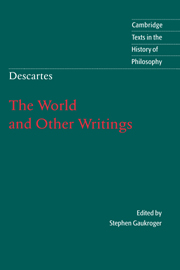Book contents
- Frontmatter
- Contents
- Acknowledgements
- Introduction
- Chronology
- Further reading
- Note on the texts
- The World and Other Writings
- The Treatise on Light
- Discourse 2 of the Dioptrics
- Discourse 8 of the Meteors
- The Treatise on Man
- Description of the Human Body
- Index
- Cambridge texts in the history of philosophy
The Treatise on Man
Published online by Cambridge University Press: 17 December 2009
- Frontmatter
- Contents
- Acknowledgements
- Introduction
- Chronology
- Further reading
- Note on the texts
- The World and Other Writings
- The Treatise on Light
- Discourse 2 of the Dioptrics
- Discourse 8 of the Meteors
- The Treatise on Man
- Description of the Human Body
- Index
- Cambridge texts in the history of philosophy
Summary
These men will be composed, as we are, of a soul and a body. And I must describe for you first the body on its own; and then the soul, again on its own; and finally I must show you how these two natures would have to be joined and united so as to constitute men resembling us.
I suppose the body to be just a statue or a machine made of earth, which God forms with the explicit intention of making it as much as possible like us. Thus He not only gives its exterior the colours and shapes of all the parts of our body, but also places inside it all the parts needed to make it walk, eat, breathe, and imitate all those functions we have which can be imagined to proceed from matter and to depend solely on the disposition of our organs.
We see clocks, artificial fountains, mills, and other similar machines which, even though they are only made by men, have the power to move of their own accord in various ways. And, as I am supposing that this machine is made by God, I think you will agree that it is capable of a greater variety of movements than I could possibly imagine in it, and that it exhibits a greater ingenuity than I could possibly ascribe to it.
- Type
- Chapter
- Information
- Descartes: The World and Other Writings , pp. 97 - 169Publisher: Cambridge University PressPrint publication year: 1998
- 7
- Cited by

